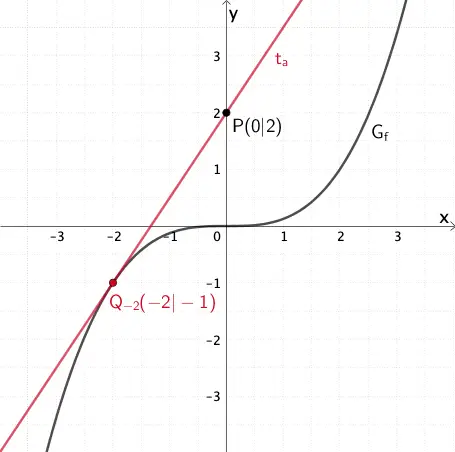Die Tangente an den Graphen von \(f\) im Punkt \(Q_{a}\) wird mit \(t_{a}\) bezeichnet. Bestimmen Sie rechnerisch denjenigen Wert von \(a \in \mathbb R\), für den \(t_{a}\) durch \(P\) verläuft.
(3 BE)
Lösung zu Teilaufgabe 4b
\[f(x) = \frac{1}{8}x^{3}; \; D_{f} = \mathbb R\]
Da die Tangente durch die Punkte \(P\) und \(Q_{a}\) verlaufen soll, gilt einerseits für deren Steigung:
\(m_{a} = \dfrac{a^{3} - 16}{8a}\) (vgl. Teilaufgabe 4a).
Anwendung der Differetialrechnung:
Steigung \(m_{T}\) einer Tangente \(T\) an den Graphen einer Funktion \(f\) im Punkt \(P\,(\,x_0\,|\,f(x_0)\,)\)
\[m_{T} = f'(x_0)\]
(vgl. Merkhilfe)
Andererseits ist die Steigung einer Tangente an den Graphen der Funktion \(f\) an einer Stelle \(a \in \mathbb R\) gegeben durch \(f'(a)\).
\(\Rightarrow \enspace f'(a) = m_{a}\)

Ableitungen der Grundfunktionen
\[c' = 0 \enspace (c \in \mathbb R)\]
\[\left( x^r \right)' = r \cdot x^{r - 1} \enspace (r \in \mathbb R)\]
\[\left( \sqrt{x} \right)' = \frac{1}{2\sqrt{x}}\]
\[\left( \sin{x} \right)' = \cos{x}\]
\[\left( \cos{x} \right)' = -\sin{x}\]
\[\left( \ln{x} \right)' = \frac{1}{x}\]
\[\left( \log_{a}{x}\right)' = \frac{1}{x \cdot \ln{a}}\]
\[\left( e^x \right)' = e^x\]
\[\left(a^x \right)' = a^x \cdot \ln{a}\]
vgl. Merkhilfe
Faktorregel
\[\begin{align*}f(x) &= a \cdot \textcolor{#0087c1}{u(x)} \\[0.8em] f'(x) &= a \cdot \textcolor{#0087c1}{u'(x)}\end{align*}\]
Summenregel
\[\begin{align*}f(x) &= \textcolor{#0087c1}{u(x)} + \textcolor{#cc071e}{v(x)} \\[0.8em] f'(x) &= \textcolor{#0087c1}{u'(x)} + \textcolor{#cc071e}{v'(x)}\end{align*}\]
Produktregel
\[\begin{align*}f(x) &= \textcolor{#0087c1}{u(x)} \cdot \textcolor{#cc071e}{v(x)} \\[0.8em] f'(x) &= \textcolor{#0087c1}{u'(x)} \cdot \textcolor{#cc071e}{v(x)} + \textcolor{#0087c1}{u(x)} \cdot \textcolor{#cc071e}{v'(x)}\end{align*}\]
Quotientenregel
\[\begin{align*}f(x) &= \dfrac{\textcolor{#0087c1}{u(x)}}{\textcolor{#cc071e}{v(x)}} \\[0.8em] f'(x) &= \dfrac{\textcolor{#0087c1}{u'(x)} \cdot \textcolor{#cc071e}{v(x)} - \textcolor{#0087c1}{u(x)} \cdot \textcolor{#cc071e}{v'(x)}}{[\textcolor{#cc071e}{v(x)}]^{2}}\end{align*}\]
Kettenregel
\[\begin{align*}f(x) &= \textcolor{#0087c1}{u(}\textcolor{#cc071e}{v(x)}\textcolor{#0087c1}{)} \\[0.8em] f'(x) &= \textcolor{#0087c1}{u'(}\textcolor{#cc071e}{v(x)}\textcolor{#0087c1}{)} \cdot \textcolor{#cc071e}{v'(x)}\end{align*}\]
vgl. Merkhilfe
Die erste Ableitung von \(f(x) = \dfrac{1}{8}x^{3}\) ist \(f'(x) = \dfrac{3}{8}x^{2}\). Somit ergibt sich:
\[\begin{align*} f'(a) &= m_{a} &&| \; f'(x) = \frac{3}{8}x^{2} \\[0.8em] \frac{3}{8}a^{2} &= \frac{a^{3} - 16}{8a} &&| \cdot 8a \\[0.8em] 3a^{3} &= a^{3} - 16 &&| - a^{3} \\[0.8em] 2a^{3} &= -16 &&| : 2 \\[0.8em] a^{3} &= -8 &&| \; \sqrt[3]{(\dots)} \\[0.8em] a &= -2\end{align*}\]

Für \(\textcolor{#cc071e}{a = -2}\) verläuft die Tangente \(\textcolor{#cc071e}{t_{a}}\) an den Graphen der Funktion \(f \colon x \mapsto \dfrac{1}{8}x^{3}\) durch den Punkt \(P(0|2)\) (Zeichnung nicht verlangt).

